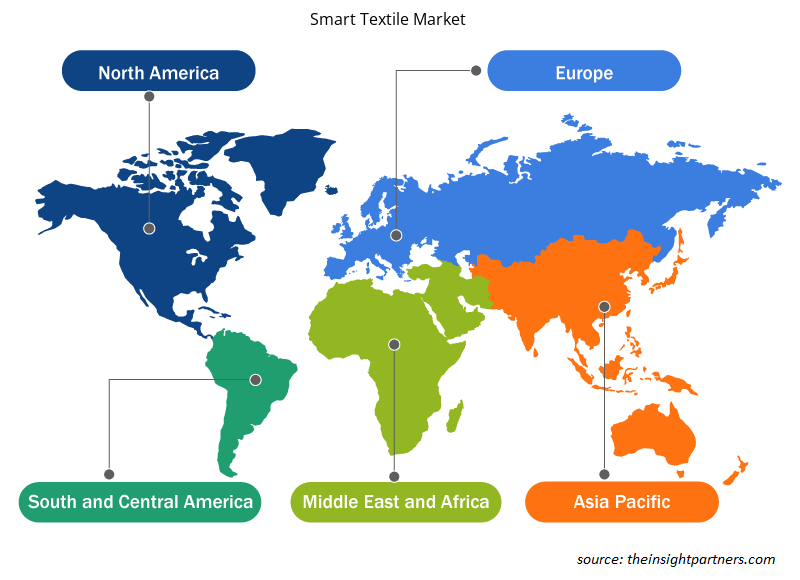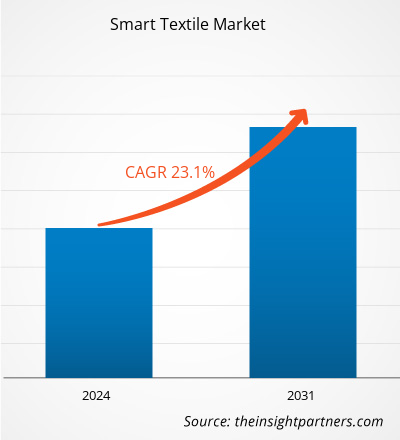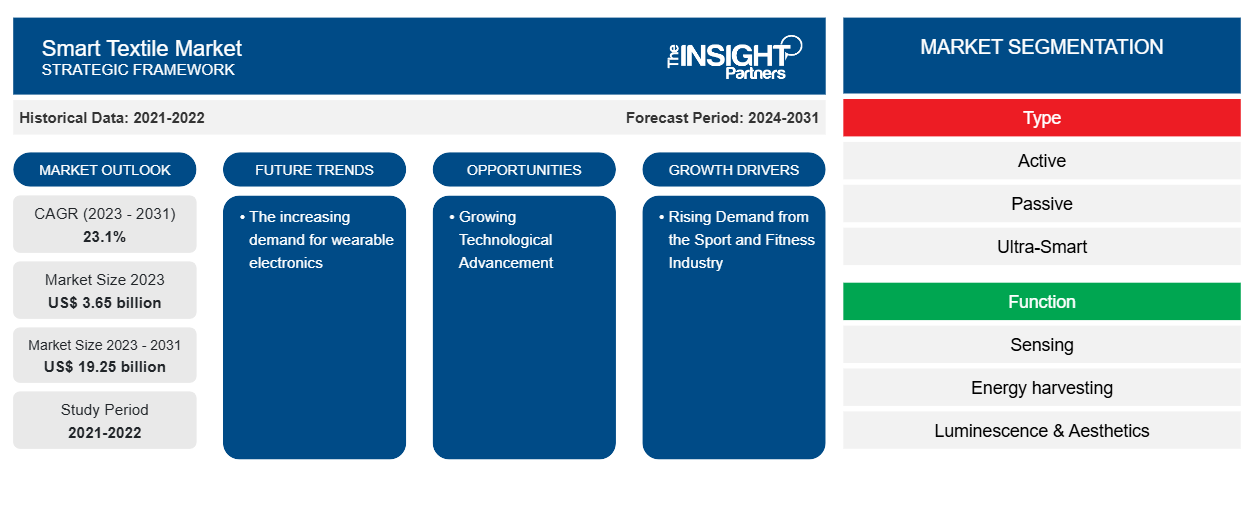Se prevé que el tamaño del mercado de textiles inteligentes alcance los 19.250 millones de dólares en 2031, frente a los 3.650 millones de dólares en 2023. Se espera que el mercado registre una CAGR del 23,1 % entre 2023 y 2031. Es probable que la creciente demanda de dispositivos electrónicos portátiles siga siendo una tendencia clave en el mercado de textiles inteligentes.
Análisis del mercado de textiles inteligentes
El sector textil ha experimentado una enorme transformación gracias a los avances en los materiales textiles inteligentes, que han permitido a las empresas ampliar su alcance hacia aplicaciones de alta tecnología y áreas fuera de su mercado convencional. Los textiles inteligentes son materiales a los que se les ha incorporado potencia computacional para ofrecer funciones adicionales como estimulación, comunicación y monitoreo. La industria de la electrónica portátil se está expandiendo debido a la disminución de las tendencias de reducción de personal en la electrónica moderna y la creciente demanda de dispositivos inteligentes. El desarrollo de la tecnología RFID , las tecnologías de sensores y la nanotecnología en los textiles también ha impulsado la expansión del mercado.
Panorama del mercado de textiles inteligentes
Los textiles inteligentes son aquellos que se han combinado con elementos digitales como fibras conductoras, microcontroladores y sensores. Estos textiles poseen la capacidad de percibir, responder y adaptarse a cambios en su entorno o estímulos de origen químico, mecánico o térmico. Los textiles inteligentes, a diferencia de los materiales habituales, incluyen características interactivas que pueden transferir datos. Se utilizan cada vez más en los sectores de la salud, el deporte, la moda y el ejército. En el ámbito de la salud, pueden controlar los signos vitales y notificar al personal médico. Son capaces de rastrear parámetros de rendimiento en los deportes. Los usos militares incluyen camuflaje mejorado y chalecos antibalas con dispositivos de comunicación integrados.
Personalice este informe según sus necesidades
Obtendrá personalización en cualquier informe, sin cargo, incluidas partes de este informe o análisis a nivel de país, paquete de datos de Excel, así como también grandes ofertas y descuentos para empresas emergentes y universidades.
-
Obtenga las principales tendencias clave del mercado de este informe.Esta muestra GRATUITA incluirá análisis de datos, desde tendencias del mercado hasta estimaciones y pronósticos.
Factores impulsores y oportunidades del mercado de textiles inteligentes
Demanda creciente de la industria del deporte y el fitness
Los amantes del fitness y los deportistas buscan constantemente métodos para mejorar los resultados y el rendimiento de sus entrenamientos. Los textiles inteligentes son perfectos para esta optimización. Estos textiles, que van desde calcetines que evalúan la marcha hasta camisetas que rastrean la actividad muscular, ofrecen una multitud de datos que pueden utilizarse para modificar los planes de entrenamiento y evitar accidentes. Además, los datos recopilados se pueden sincronizar con teléfonos inteligentes u otros dispositivos, lo que permite una acción instantánea en respuesta a la retroalimentación en tiempo real. Tanto los atletas como los corredores ocasionales pueden ahora acceder a este grado de recopilación de datos de grano fino que antes era exclusivo de los laboratorios deportivos especializados. Además, el creciente enfoque global en las tendencias de salud y bienestar está impulsando la demanda de textiles inteligentes en los deportes y el fitness, ya que proporcionan una forma sencilla de controlar numerosos datos que pueden contribuir a un estilo de vida mejor y más activo.
Creciente avance tecnológico
El negocio textil ha cambiado como resultado de la introducción de nuevas tecnologías como la inteligencia artificial (IA) y el Internet de las cosas (IoT). La IA, el Bluetooth Low Energy (BLE), la informática de borde y los datos en la nube se están combinando en la nueva ropa inteligente que se está produciendo. Esta ropa puede monitorear y transmitir los datos del usuario, como la temperatura, la frecuencia cardíaca, la presión arterial y la transpiración. La IA tiene la capacidad de recuperar y recopilar datos operativos tanto del pasado como del presente, así como ofrecer información que puede mejorar la productividad del usuario. La IA se utiliza con frecuencia en la fabricación de textiles para una variedad de propósitos, incluida la combinación de colores, la inspección de patrones y la detección de defectos. Además, la integración de la IA ha hecho posible producir ropa inteligente que utiliza sensores eléctricos y de IoT para brindar una excelente experiencia de usuario. Por lo tanto, la incorporación de tecnologías en los textiles puede crear una experiencia más cómoda y orientada a la salud, lo que se espera que cree una oportunidad para el crecimiento del mercado de textiles inteligentes en el período previsto.
Análisis de segmentación del informe del mercado de textiles inteligentes
Los segmentos clave que contribuyeron a la derivación del análisis del mercado de textiles inteligentes son el tipo, la función y la vertical de la industria.
- Según el tipo, el mercado de textiles inteligentes se segmenta en activo, pasivo y ultrainteligente. Se prevé que el segmento activo crezca en el período previsto.
- Por función, el mercado está segmentado en detección, recolección de energía, luminiscencia y estética, y termoelectricidad. Se prevé que el segmento de detección crezca en el período previsto.
- Por sector industrial, el mercado está segmentado en atención médica, deportes y fitness, moda, militar y automotriz. Se prevé que el segmento de deportes y fitness crezca en el período previsto.
Análisis de la cuota de mercado de los textiles inteligentes por geografía
El alcance geográfico del informe del mercado de textiles inteligentes se divide principalmente en cinco regiones: América del Norte, Asia Pacífico, Europa, Medio Oriente y África, y América del Sur/América del Sur y Central.
En términos de ingresos, América del Norte representó la mayor participación en el mercado de textiles inteligentes. El mercado en esta región está segmentado en Estados Unidos, Canadá y México. La expansión del mercado regional está impulsada por la creciente inversión gubernamental en las industrias de defensa y militar, así como por un fuerte poder adquisitivo. Además, una gran parte de la población de la región sufre de obesidad, lo que la convierte en uno de los principales problemas de salud. Como resultado, los consumidores están gravitando hacia un estilo de vida saludable y comprando productos que respalden su actividad física continua. En consecuencia, para seguir siendo competitivos, los actores del mercado están centrando sus esfuerzos en proporcionar artículos de vanguardia a costos asequibles. Además, el aumento del gasto gubernamental en iniciativas de I+D, en particular en la industria de la salud, está impulsando aún más el crecimiento del mercado de textiles inteligentes.
Perspectivas regionales del mercado de textiles inteligentes
Los analistas de Insight Partners explicaron en detalle las tendencias y los factores regionales que influyen en el mercado de textiles inteligentes durante el período de pronóstico. Esta sección también analiza los segmentos y la geografía del mercado de textiles inteligentes en América del Norte, Europa, Asia Pacífico, Oriente Medio y África, y América del Sur y Central.

- Obtenga datos regionales específicos para el mercado de textiles inteligentes
Alcance del informe sobre el mercado de textiles inteligentes
| Atributo del informe | Detalles |
|---|---|
| Tamaño del mercado en 2023 | 3.650 millones de dólares estadounidenses |
| Tamaño del mercado en 2031 | US$ 19.250 millones |
| CAGR global (2023 - 2031) | 23,1% |
| Datos históricos | 2021-2022 |
| Período de pronóstico | 2024-2031 |
| Segmentos cubiertos |
Por tipo
|
| Regiones y países cubiertos |
América del norte
|
| Líderes del mercado y perfiles de empresas clave |
|
Densidad de actores del mercado: comprensión de su impacto en la dinámica empresarial
El mercado de textiles inteligentes está creciendo rápidamente, impulsado por la creciente demanda de los usuarios finales debido a factores como la evolución de las preferencias de los consumidores, los avances tecnológicos y una mayor conciencia de los beneficios del producto. A medida que aumenta la demanda, las empresas amplían sus ofertas, innovan para satisfacer las necesidades de los consumidores y aprovechan las tendencias emergentes, lo que impulsa aún más el crecimiento del mercado.
La densidad de actores del mercado se refiere a la distribución de las empresas o firmas que operan dentro de un mercado o industria en particular. Indica cuántos competidores (actores del mercado) están presentes en un espacio de mercado determinado en relación con su tamaño o valor total de mercado.
Las principales empresas que operan en el mercado de textiles inteligentes son:
- Dupont
- Jabil
- Sensorial
- Ropa interactiva AG
- Adidas
- Hexoskin
Descargo de responsabilidad : Las empresas enumeradas anteriormente no están clasificadas en ningún orden particular.

- Obtenga una descripción general de los principales actores clave del mercado de textiles inteligentes
Noticias y desarrollos recientes del mercado de textiles inteligentes
El mercado de textiles inteligentes se evalúa mediante la recopilación de datos cualitativos y cuantitativos a partir de investigaciones primarias y secundarias, que incluyen publicaciones corporativas importantes, datos de asociaciones y bases de datos. A continuación, se incluye una lista de los avances del mercado:
- Loomia Technologies se asoció con Advanced Functional Fabrics of America (AFFOA) para desarrollar guantes térmicos y altamente táctiles que podrían aplicarse tanto a clientes comerciales/recreativos como militares. Para este proyecto colaborativo, Loomia proporcionará tecnología que se utilizará en un inserto de guante térmico, mientras que AFFOA liderará el descubrimiento de clientes, entregará diseños de arquitectura de sistemas y producirá una unidad de control de interfaz. Además del inserto de guante térmico, Loomia también desarrollará una manga térmica. Ambos artículos brindarán comodidad térmica a los usuarios en climas severos u otras áreas donde se considere necesaria esta protección. (Fuente: Loomia Technologies, comunicado de prensa, 2022)
- La Asociación de Moda y Textiles del Reino Unido (UKFT) anunció una asociación con Smart Textile Alliance. La asociación entre STA y UKFT será mutuamente beneficiosa y abrirá el potencial para nuevas vías de innovación en tecnología y moda. (Fuente: UKFT, comunicado de prensa, 2021)
Cobertura y resultados del informe sobre el mercado de textiles inteligentes
El informe “Tamaño y pronóstico del mercado de textiles inteligentes (2021-2031)” proporciona un análisis detallado del mercado que cubre las siguientes áreas:
- Tamaño del mercado y pronóstico a nivel global, regional y nacional para todos los segmentos clave del mercado cubiertos bajo el alcance
- Dinámica del mercado, como impulsores, restricciones y oportunidades clave
- Principales tendencias futuras
- Análisis detallado de las cinco fuerzas de Porter y PEST y FODA
- Análisis del mercado global y regional que cubre las tendencias clave del mercado, los principales actores, las regulaciones y los desarrollos recientes del mercado.
- Análisis del panorama de la industria y de la competencia que abarca la concentración del mercado, el análisis de mapas de calor, los actores destacados y los desarrollos recientes
- Perfiles detallados de empresas
- Análisis histórico (2 años), año base, pronóstico (7 años) con CAGR
- Análisis PEST y FODA
- Tamaño del mercado, valor/volumen: global, regional y nacional
- Industria y panorama competitivo
- Conjunto de datos de Excel
Informes recientes
Testimonios
Razón para comprar
- Toma de decisiones informada
- Comprensión de la dinámica del mercado
- Análisis competitivo
- Información sobre clientes
- Pronósticos del mercado
- Mitigación de riesgos
- Planificación estratégica
- Justificación de la inversión
- Identificación de mercados emergentes
- Mejora de las estrategias de marketing
- Impulso de la eficiencia operativa
- Alineación con las tendencias regulatorias























 Obtenga una muestra gratuita para - Mercado textil inteligente
Obtenga una muestra gratuita para - Mercado textil inteligente